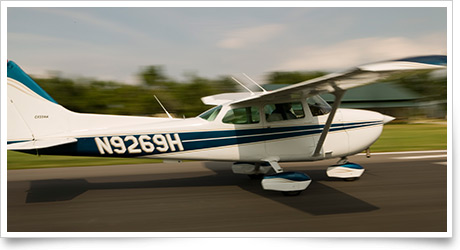training tipsOperation rotation
The next departing trainer puts on a more entertaining performance. The moment when the nosewheel rises comes more abruptly, and the nose attitude appears more extreme. Acceleration seems sluggish, and it is not until the pitch is lowered a bit that the aircraft begins to climb (from a point much farther down the runway).
The difference in the two departures reflected the two pilots' differing skill handling the brief but crucial phase of a takeoff run referred to as rotating the aircraft.
What exactly is “rotation”?
“When all the flight controls become effective during the takeoff roll in a nosewheel-type airplane, back elevator pressure should be gradually applied to raise the nosewheel slightly off the runway, thus establishing the takeoff or lift-off attitude. This is often referred to as ‘rotating,’” explains Chapter 5 of the Airplane Flying Handbook.
You learned in ground school that an aircraft can be maneuvered—that is, rotated—around any of three axes. Rotating the aircraft around the lateral (or pitch) axis with up-elevator pressure is what lifts the nosewheel from the runway and also increases the angle of attack of the wing. In a normal takeoff, this should occur at a manufacturer-designated airspeed. For that 1980 Cessna 152, it is 50 knots indicated airspeed (KIAS).
One important tip to remember is that rotation is not the start of the climb. Becoming airborne usually requires additional acceleration. Meantime, patiently maintain your straight track down the runway, holding wings level and the proper pitch attitude, adjusting your inputs as control effectiveness increases with increasing airspeed.
What is the proper pitch attitude?
“One description is to raise the pitch attitude until the front cowling appears to cover up the runway ahead. Another is to raise the end of the cowling to the horizon,” advises the Flight Training magazine article “Takeoff Troubles.”
How and when to rotate differs with takeoff methods. So do the airspeed requirements for the initial climbs. Learning how to establish the proper pitch attitude for each brand of rotation will deliver the desired performance, conserving runway and maximizing safety. training productsKing Schools has released its Return to VFR Flying Kit online and on DVD. The kit targets those returning to the skies after an absence and includes materials to restore pilot knowledge and prepare for a flight review.
Roger Dodger Aviation is offering its General Aviation Home Cockpit Bundle, a series of videos that explain how to build a flight simulator desktop frame to elevate keyboards and monitors and simulate a Cessna 172.
Note: Products listed have not been evaluated by ePilot editors unless otherwise noted. AOPA assumes no responsibility for products or services listed or for claims or actions by manufacturers or vendors. final examQuestion: What is Operation Lights On?
Answer: The FAA has a voluntary pilot safety program, Operation Lights On, to enhance the see-and-avoid concept. Pilots are encouraged to turn on their landing lights during takeoff, i.e., either after takeoff clearance has been received or when beginning takeoff roll. Pilots are further encouraged to turn on their landing lights when operating below 10,000 feet, day or night, especially when operating within 10 miles of any airport, or in conditions of reduced visibility and in areas where flocks of birds may be expected, i.e., coastal areas, lake areas, around refuse dumps, etc. Although turning on aircraft lights does enhance the see-and-avoid concept, pilots should not become complacent about keeping a sharp lookout for other aircraft. Not all aircraft are equipped with lights and some pilots may not have their lights turned on. Aircraft manufacturer’s recommendations for operation of landing lights and electrical systems should be observed. Aeronautical Information Manual 4-3-23 (c) discusses the use of aircraft lights.
Got a question for our technical services staff? Email [email protected] or call the Pilot Information Center, 800/872-2672. Don’t forget the online archive of “Final Exam” questions and answers, searchable by keyword or topic. |
 A Cessna 152 is rolling down a runway for takeoff. As it accelerates, observers can see its nosewheel rise from the runway, with the aircraft continuing to roll briefly on just the two main wheels until it begins to climb.
A Cessna 152 is rolling down a runway for takeoff. As it accelerates, observers can see its nosewheel rise from the runway, with the aircraft continuing to roll briefly on just the two main wheels until it begins to climb.

